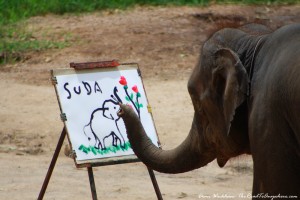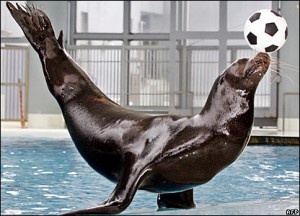“Painting Elephant in Thailand”
This is a short montage of an elephant show in a zoo in Thailand. The first part of the video is of elephants lined up and “jamming out” to music while playing harmonicas. The music is up beat and cheery as the audience awww and cheers on the elephants. They are nodding their heads up and down and the men in the background are standing around the elephants with cattle prods or sticks of some kind, clearly this implies that this is not a natural behavior, the elephants have been trained to “enjoy” this music.
The next part of the video is a zoom in of another part of the elephant show. The music becomes very relaxing and there is a close-up of an elephant painting. The elephant, Suda, is holding the brush in her trunk. There are many videos of elephants painting on youtube and while trainers claim it is a way for the elephants to practice and demonstrate the adeptness of their trunks, generally this is also not a natural behavior.
The elephant also paints a picture of an elephant reaching for tree leaves and while this is meant to show self-awareness, it is important to the viewer to remember that this is a learned trick. It has been taught to the elephants by their trainers as an effort to entertain the crowd and gain publicity for their business. However, if one wanted to view this in a less cynical manner an argument could be made that the elephant is merely demonstrating it’s intelligence and ability to use it’s trunk. It can be viewed as a way of educating the public about the intelligence of the animal. The camera then pans over to the crowd who applauds Suda and gets up to take pictures on the other side of a railing, clearly the audience is showing
Suda is even taught to write her own name again demonstrating self awareness. But is she actually aware that this is her name and this is what she looks like? Is she expressing herself through painting? Or is she merely doing a trick taught to her to amuse the public?
Finally, there is a clip of an elephant, presumably Suda, “playing with a soccer ball.” In this clip you see the trainers fully and that they are standing with Suda as she kicks the soccer ball very far. Then as the crowd applauds, presumably Suda is given another command and she throws the ball behind her and kicks it with her back foot. Again an argument can be made that this could be an excursive for Suda, so she keeps up her agility and this is just a playful trick that she enjoys doing. However these tricks that she has been taught do demonstrate her intelligence they are not natural behaviors that an elephant would do and clearly she has been trained them through a technique of “punishment and reward” based on her performance.
Malamud author of Zoo Spectatorship argues that zoo spectatorship, like as what had happened with Suda, is not for the animal but for the humans. He even discusses how zoos express human propensity for imperialism.
Human control over zoo animals celebrates an imperial relation toward the realm of nature and its subordination to our whims. But in the long term, a human society that expresses its relationship to the natural world via the institution of zoos risks foundering amid our imperious ecological ethos (Malamud 228).
What he is saying is that human propensity for control over other beings has led to the popularity of zoos, we enjoy and are entertained by our ability to control other animals. In the case of this video, elephant painting itself, playing music, and kicking a soccer ball, we delight in the fact that we have been able to pass on our knowledge on another animal and are able to control it for our entertainment. This is a very common practice among zoos, where they claim to be educating the public about the animal when in reality they are teaching animals human behavior which is not natural to the animal. Some may argue that this deepens our relationship with the animal. I have to agree with Malamud however, while I did enjoy watching an elephant paint a self portrait, I also understand that this wasn’t the elephant expressing itself through a creative medium it was a learned behavior that is not natural to the animal and was only preformed after training Suda through a means of punishment and reward. Another way of expressing our control over animals.




Recent Comments